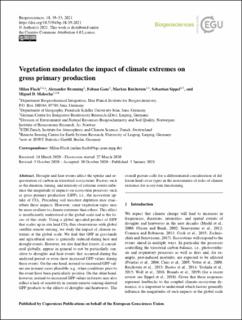Vegetation modulates the impact of climate extremes on gross primary production
| dc.contributor.author | Flach, Milan | |
| dc.contributor.author | Brenning, Alexander | |
| dc.contributor.author | Gans, Fabian | |
| dc.contributor.author | Reichstein, Markus | |
| dc.contributor.author | Sippel, Sebastian | |
| dc.contributor.author | Mahecha, Miguel D. | |
| dc.date.accessioned | 2021-07-19T13:24:22Z | |
| dc.date.available | 2021-07-19T13:24:22Z | |
| dc.date.created | 2021-04-19T12:47:17Z | |
| dc.date.issued | 2021-01-05 | |
| dc.identifier.citation | Biogeosciences. 2021, 18 (1), 39-53. | en_US |
| dc.identifier.issn | 1726-4170 | |
| dc.identifier.uri | https://hdl.handle.net/11250/2764784 | |
| dc.description.abstract | Drought and heat events affect the uptake and sequestration of carbon in terrestrial ecosystems. Factors such as the duration, timing, and intensity of extreme events influence the magnitude of impacts on ecosystem processes such as gross primary production (GPP), i.e., the ecosystem uptake of CO2. Preceding soil moisture depletion may exacerbate these impacts. However, some vegetation types may be more resilient to climate extremes than others. This effect is insufficiently understood at the global scale and is the focus of this study. Using a global upscaled product of GPP that scales up in situ land CO2 flux observations with global satellite remote sensing, we study the impact of climate extremes at the global scale. We find that GPP in grasslands and agricultural areas is generally reduced during heat and drought events. However, we also find that forests, if considered globally, appear in general to not be particularly sensitive to droughts and heat events that occurred during the analyzed period or even show increased GPP values during these events. On the one hand, normal-to-increased GPP values are in many cases plausible, e.g., when conditions prior to the event have been particularly positive. On the other hand, however, normal-to-increased GPP values in forests may also reflect a lack of sensitivity in current remote-sensing-derived GPP products to the effects of droughts and heatwaves. The overall picture calls for a differentiated consideration of different land cover types in the assessments of risks of climate extremes for ecosystem functioning. | en_US |
| dc.language.iso | eng | en_US |
| dc.publisher | Copernicus Publications on behalf of the European Geosciences Union | en_US |
| dc.rights | Navngivelse 4.0 Internasjonal | * |
| dc.rights.uri | http://creativecommons.org/licenses/by/4.0/deed.no | * |
| dc.title | Vegetation modulates the impact of climate extremes on gross primary production | en_US |
| dc.type | Peer reviewed | en_US |
| dc.type | Journal article | en_US |
| dc.description.version | publishedVersion | en_US |
| dc.rights.holder | © Author(s) 2021 | en_US |
| dc.source.pagenumber | 39-53 | en_US |
| dc.source.volume | 18 | en_US |
| dc.source.journal | Biogeosciences | en_US |
| dc.source.issue | 1 | en_US |
| dc.identifier.doi | 10.5194/bg-18-39-2021 | |
| dc.identifier.cristin | 1905064 | |
| dc.relation.project | EC/H2020/640176 | en_US |
| cristin.ispublished | true | |
| cristin.fulltext | original | |
| cristin.qualitycode | 1 |
Tilhørende fil(er)
Denne innførselen finnes i følgende samling(er)
-
Divisjon for miljø og naturressurser [746]
Publikasjoner knyttet til ansatte ved Divisjon for miljø og naturressurser -
Publikasjoner fra CRIStin - NIBIO [4501]
-
Vitenskapelige artikler [1416]

